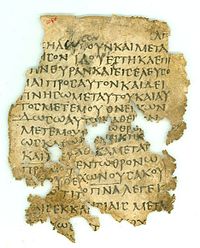Revelation 4
| Revelation 4 | |
|---|---|
 Revelation 3:19-4:3 on Uncial 0169 from the fourth century. | |
| Book | Book of Revelation |
| Category | Apocalypse |
| Christian Bible part | New Testament |
| Order in the Christian part | 27 |
Revelation 4 is the fourth chapter of the Book of Revelation or the Apocalypse of John in the New Testament of the Christian Bible. The book is traditionally attributed to John the Apostle,[1][2] but the precise identity of the author remains a point of academic debate.[3] This chapter contains an inaugural vision of heaven, portraying the throne room of heaven,[4] and the heavenly worship which the writer observes there.[5][6]
Text
The original text was written in Koine Greek. This chapter is divided into 11 verses.
Textual witnesses
Some early manuscripts containing the text of this chapter are among others:[7][a]
- Codex Sinaiticus (330-360)
- Uncial 0169 (4th century; extant verses 1–3)
- Codex Alexandrinus (400-440)
Old Testament references
God on the Throne
God's sovereignty over all things is symbolized by the throne, which visions are found both in the Hebrew Bible/Old Testament prophetic tradition (cf. 1 Kings 22:19—23) as well as in some Jewish apocalypses, and in this chapter (echoing Isaiah 6 and Ezekiel 1) is seen as "already fully acknowledged in heaven, and therefore as the true reality which must in the end prevail on earth".[6] Taken up into heaven, John can see that "God's throne is the ultimate reality behind all earthly appearances".[6]
Verse 1
- After these things I looked, and behold, a door standing open in heaven.
- And the first voice which I heard was like a trumpet speaking with me, saying, "Come up here, and I will show you things which must take place after this."[10]
"After these things" refers back to "the entire vision in
Verse 8
- The four living creatures, each having six wings, were full of eyes around and within. And they do not rest day or night, saying:
- “Holy, holy, holy,
- Lord God Almighty,
- Who was and is and is to come!”[12]
- ", 8).[14]
Verse 11
- "You are worthy, O Lord,
- To receive glory and honor and power;
- For You created all things,
- And by Your will they exist and were created."[15]
The depiction of God's sovereignty starts with him as the 'Creator of all things', then as 'Redeemer' to restore his universal sovereignty on earth (
See also
- Book of Daniel
- Holy, Holy, Holy! Lord God Almighty, 19th-century English Christian hymn
- John the Apostle
- John's vision of the Son of Man
- Revelation Song
- Tetramorph
- Related Bible parts: Isaiah 6, Ezekiel 1, Revelation 5, Revelation 6
Notes
- ^ The Book of Revelation is missing from Codex Vaticanus.[8]
References
- ISBN 0802823882.
- ISBN 0781442281.
- ^ F. L. Cross, The Oxford Dictionary of the Christian Church, (New York: Oxford University Press, 1997), 45
- ^ Revelation 4:1–11: New King James Version
- ^ Revelation 4:1–11: New Revised Standard Version
- ^ a b c Bauckham 2007, p. 1292.
- ^ Elliott, J. K. "Revelations from the apparatus criticus of the Book of Revelation: How Textual Criticism Can Help Historians." Union Seminary Quarterly Review 63, no. 3-4 (2012): 1-23.
- ^ Claremont Coptic Encyclopaedia, Codex Vaticanus, accessed 29 September 2018
- ^ "Biblical concordances of Revelation 4 in the 1611 King James Bible".
- ^ Revelation 4:1 NKJV
- ^ Meyer, H. A. W., Meyer's NT Commentary on Revelation 4, accessed 15 October 2018
- ^ Revelation 4:8 NKJV
- ^ Bauckham 2007, pp. 1292–1293.
- ^ a b Bauckham 2007, p. 1293.
- ^ Revelation 4:11 NKJV
Bibliography
- ISBN 978-0199277186. Retrieved February 6, 2019.
External links
- Revelation 4 King James Bible - Wikisource
- English Translation with Parallel Latin Vulgate Archived 2019-06-17 at the Wayback Machine
- Online Bible at GospelHall.org (ESV, KJV, Darby, American Standard Version, Bible in Basic English)
- Multiple bible versions at Bible Gateway (NKJV, NIV, NRSV etc.)
